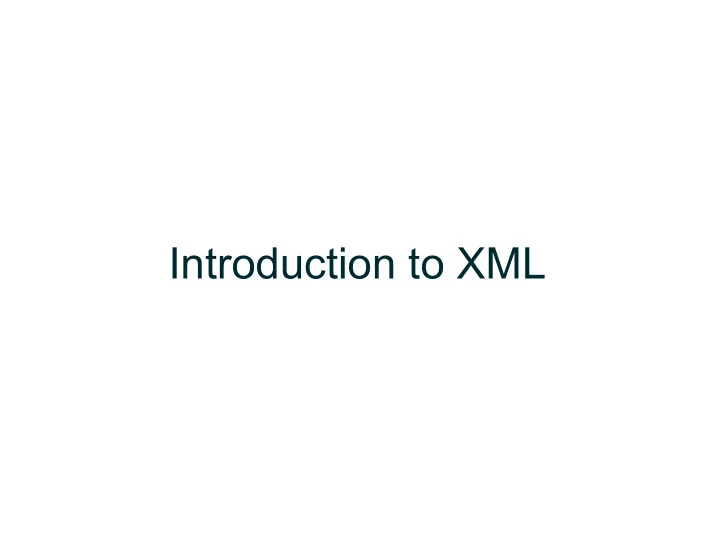

Introduction to XML
What markup languages have you used (or looked at) (or heard of)?
What markup languages have you used (or looked at) (or heard of)? • (X)HTML (Web pages) • EAD (archival finding aids) • DocBook (books, such as manuals) • TEI (texts) • MEI (music)
What are they for? Why have so many different disciplines developed ways to mark up their texts?
What are they for? They make explicit certain features of text in order to aid the processing of that text by computer programs.
We encode texts because plain text isn’t good enough ( for what we want to do ) What if you want to... 123 Kelly Road Dublin 19 Publish a collec4on of le5ers and decide 15 January 2009 a8er beginning that you want to have the sender’s address and closing always Dear Awards Committee: right‐aligned? The candidate has fine penmanship. Search your collec4on of le5ers to Sincerely yours, extract a list of all senders and another list of all recipients? Jane Murphy
Word processor styles: Encoding under the surface
Extensible Markup Language (XML): word processor styles on steroids Can have one style inside another (‘nes4ng’) • There's a 4tle in this cita4on! • There's a quote in this paragraph! Can give proper4es to these styles, e.g., • This saluta4on is formal. • This sentence is sarcas4c. • This word is misspelled. Can define the proper order of styles Each le5er contains one address, followed by one date, followed by one saluta4on
XML in brief (1) Open, non‐proprietary standard Stored in plain text but usually thought of as contras4ng with it (as above) Marks beginning and ends of spans of text using tags: <sentence>This is a sentence.</sentence>
XML in brief (2) Spans of text must nest properly: Wrong: <sentence>Overlap is <emphasis>not allowed!</sentence></emphasis> Right: <sentence>Overlap is <emphasis>not allowed!</emphasis></sentence>
Elements (tags), attributes, values, content <sentence type=“declara4ve”>This is a sentence.</sentence> <sentence type=“interroga4ve”>Is this is a sentence?</sentence>
Elements (tags), attributes, values, content Elements may have one a>ribute, many a>ributes, or none, but each a>ribute on any given element must be unique. Valid: <sentence type=“declara4ve”>This is a sentence.</sentence> Valid: <sentence type=“interroga4ve” xml:lang=”en”>Is this is a sentence?</sentence> Valid: <sentence>This is a sentence.</sentence> Invalid: <sentence type=“declara4ve” type=“true”>This is a sentence.</sentence>
XML as a tree We use family tree terms: parent, child, sibling, ancestor, and descendent. Remember, everything must nest properly!
Wait, this all looks a lot like HTML! HTML is a specific implementa4on of XML (well, actually, its predecessor SGML) that has pre‐defined elements and a5ributes. You can’t create your own elements, so its usefulness is limited.
Schemas (DTDs and others) A syntax for your XML documents, specifying: Which elements are allowed Which elements may nest inside of others In what order these elements must occur How many 4mes they may repeat What a5ributes they may have What values those a5ributes may have h5p://www.tei‐c.org/release/doc/tei‐p5‐doc/en/html/ST.html#STIN
Why would you want to constrain your document structure like this? Prevent errors in crea4ng the XML Make it easier to search the text Remember we were going to extract names of senders and recipients? You know where to expect to find them within your XML documents.
Structure, not appearance Most people use XML to describe the structure of a document rather than its appearance. Informa4on about how to render various components of the document is usually stored separately, in a stylesheet .
But how do we... Know what element and a5ribute names to use? Make decisions about defining and constraining our document structure? Avoid reinven4ng the wheel, and build on work that's already been done? Ensure that our texts can be understood and used by others?
Use something that already exists! http://www.tei-c.org/index.xml http://www.tei-c.org/Guidelines/P5/index.xml
Questions?
Recommend
More recommend